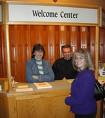
Part 1 of this series began with a list of questions about a guest’s experience in your Sunday School. Sitting down with your Sunday School team to ask them to think about what would happen can be a worthwhile experience. The bottom line question from the experience, where there are problems/holes, would they be willing to work to fix them?
In Part 1 of this two-part series, I shared the first five of ten “spaces of opportunity” in your Sunday School to make a great first impression. These included the parking lot, church entrance, welcome center, hallways, and classroom door. In Part 2, I will share the final five spaces:
- CLASSROOM. Last time, I mentioned several actions related to the classroom door including greeting, registration, name tags, and introduction. Make sure the guest has a good seat. At this point, the teacher and attenders have a responsibility of being interested (not nosey) in the guest. Good listening skills are helpful. Class prayer requests are explained. The greeter sits close and continues to help and explain class practices as needed.
- TEACHING-LEARNING EXPERIENCE. The teacher should call the guest by name and involve the guest in the lesson (without embarrassing him/her). This may mean not asking him/her to read, pray, or answer a question out loud (unless he/she volunteers). Share a pupil book–tell the guest on what page the lesson begins. If the class has more than five people, dividing the class into small groups for sharing an assignment may make the guest more comfortable to respond. The greeter watches with heightened sensitivity for any sign of discomfort.
- RESTROOMS. Restrooms should have someone check on them during Sunday School. Pick up and empty trash if needed. Address any odors immediately. Clean sink and/or mirrors if needed. Flush toilets if needed. At the end of class, the greeter will want to walk the guest to the restroom and to pick up children (if appropriate). It would be a shame to have made a great first impression until the guest enters the restroom!
- WORSHIP. The greeter walks the guest to the sanctuary after the trip to the restroom and/or picking up the guest’s children. There, worship greeters should be in place to welcome and share a worship guide and/or printed announcements. The greeter should ask where the guest would prefer to sit, and the greeter will sit with the guest and introduce him/her to others sitting nearby. Church members should be proactive in greeting the guest before, during, and after the official time of greeting. Again, avoid embarrassing guests.
- FOLLOW UP. This is a matter of showing you care. There are many opportunities to do so. The greeter who spent so much time getting to know and help the guest will want to call. Thank the guest for attending class, ask if he/she had any questions, invite to an upcoming fellowship, and ask if he/she has any prayer requests. Close in a brief prayer. The teacher may also want to touch base by phone, email, or handwritten note. The pastor and staff will want to touch base as well. Some churches ask Deacons to make a visit. A Sunday School class team may want to make a visit the second week. Don’t overwhelm the guest, but show you care by following up.
Rate your Sunday School on a scale from 1 (poor) to 10 (great) in each of these five spaces. Add up your ratings. How did you do? If you scored 40 or more, you treat guests well. If you scored 30-39, identify and work o n a couple of “space for opportunity” in need of improvement. If you scored below 30, lead improvement to become a priority. Take steps immediately to address your spaces with low scores. (Combine the two Parts of this series and prioritize your plan of action.)
If you make a great first impression, you will be more likely to see guests return. And they will be more likely to connect and stay. Your efforts will be rewarded with class and Sunday School maturational and numerical growth. Care about every guest. Care for every guest. Invite. Enroll. Follow up. Be revolutionary!
Leave a Reply